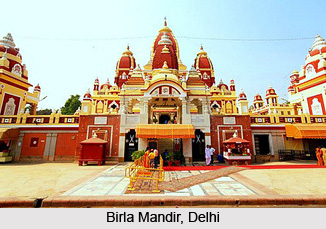 Laxminarayan temple, also known as Birla Mandir, is a Hindu temple situated in Delhi. The temple is dedicated to Laxminarayan, which refers to Lord Vishnu (also known as Narayan) in consort with Goddess Lakshmi. The former is the god of preserver and the latter is the goddess of prosperity. The temple was established in the year 1938 by B. R. Birla and Jugal Kishore Birla. Mahatma Gandhi inaugurated the temple on the condition that people belonging to all the castes would be allowed to visit the temple. The temple spans over an area of 7.5 acres and the temple premise is embellished with numerous shrines, beautiful fountains, a spectacular garden and a Geeta Bhawan for discourses.
Laxminarayan temple, also known as Birla Mandir, is a Hindu temple situated in Delhi. The temple is dedicated to Laxminarayan, which refers to Lord Vishnu (also known as Narayan) in consort with Goddess Lakshmi. The former is the god of preserver and the latter is the goddess of prosperity. The temple was established in the year 1938 by B. R. Birla and Jugal Kishore Birla. Mahatma Gandhi inaugurated the temple on the condition that people belonging to all the castes would be allowed to visit the temple. The temple spans over an area of 7.5 acres and the temple premise is embellished with numerous shrines, beautiful fountains, a spectacular garden and a Geeta Bhawan for discourses.
History of Laxminarayan Temple
The construction work of the temple began in the year 1933. The temple derives its name form its founders Baldeo Das Birla (industrialist and philanthropist) and his son Jugal Kishore Birla, who belonged to the Birla family. Maharaj Udaybhanu Singh laid the foundation stone of the temple and the construction was done under the supervision of Pandit Vishwanath Shastri. Swami Keshwa Nandji performed the Yagna and the concluding ceremony of the temple.
Architecture of Laxminarayan Temple
Hindu temple architecture has structured this magnificent three storied temple in the specific Nagara style. Artistic carvings adorn the entire temple illustrating scenes from Hindu mythology. The icons of the temple were carved by numerous adept artisans who hailed from Benaras (presently Varanasi) under the supervision of Acharya Vishvanath Shastri. Over the main sanctum, a high "shikhara" rises up to a height of 160 feet. The temple stands on a high plinth facing towards the east. Depiction of the life and works of the presiding deity can be witnessed in fresco paintings that embellish the main shrine. The icons of deities have been carved with marble brought from Jaipur. The temple premise is made of Kota stone which were brought from Jaisalmer, Kota, Agra and Makarana. Standing towards the north is the Geeta Bhawan which is dedicated to Lord Krishna. Enchanting artificial landscape has been created to augment the beauty of the temple.
In the main temple, idols of Lord Narayan and Goddess Lakshmi have been enshrined. Besides this, several small shrines are situated which are dedicated to Lord Hanuman, Lord Ganesha, Lord Shiva and Lord Buddha.





















